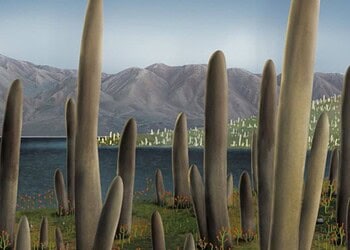If you zoom in on it, the pin mold fungus Phycomyces blakesleeanus looks like a ghastly pine forest with its thin, elongated bodies reaching upwards. But how does the fungus know which way is up? According to a new study, it does so via a bacteria gene that it acquired and tweaked in order to create gravity-sensing crystals.

Most people would consider fungi pretty dull — after all, all they do is grow, spread their spores and then grow some more. However, fungi have much more going for them than it initially appears.
How do you know which way is up (bonus points if you’ve read or seen Ender’s Game)? For us, as humans, the question almost doesn’t make any sense. Without going too much into the biomechanics of how we sense which way is up and which way is down, suffice to say that all animals have at least some idea of up and down. But plants and fungi grow upwards, so they, too, have developed mechanisms that aid them.
Researchers have known for quite a while that the pin mold fungus has octahedral protein crystals that, when placed in fluid-filled chambers (vacuoles), detect gravity. However, it was unclear exactly when and how they developed this ability. In order to clear this up, biologists purified the crystals and identified a protein which they named OCTIN. They found clear evidence of something called horizontal gene transfer, meaning that the fungus borrowed the ability from bacteria.
Basically, genetic information can be transmitted either vertically (from parents to offspring) or horizontally. Horizontal gene transfer (HGT) occurs when DNA is transferred between unrelated individuals. It typically happens to acquire useful functions, such as resistance to environmental extremes and expanded metabolic capacity. However, in most cases, HGT tends to happen through enzymes that confer these traits, and the original and acquired functions tend to remain closely related to each other.
This time, that’s wasn’t the case.
“We were surprised that OCTIN-related genes are found in bacteria and that all the evidence pointed to horizontal gene transfer from bacteria into the ancestor of Phycomyces,” said the authors. “This was intriguing because estimates of sedimentation show that bacteria are too small to employ gravity sensing structures. This made it clear that we were looking at the emergence of an evolutionary novelty based on how the proteins assembled.”
It’s also remarkable that the fungal OCTIN crystals can dramatically swell and dissolve based on the biochemical environment, which forms or breaks bonds between proteins. This also happens in bacteria, but on a much smaller scale. The overall crystal size was also much larger in the fungus than in the bacteria.
The presence of the OCTIN protein is not the end of the story. Researchers took things one step further and tried to “convince” mammalian cells to make fungal OCTIN, but these cells did not form crystals. Dr. Gregory Jedd, who led the group at the Temasek Life Sciences Laboratory from the National University of Singapore, concluded:
“We are currently searching for these factors with the aim of reconstituting OCTIN crystal formation in the test tube. This will allow us to better understand and manipulate the assembly process and its products. High-order assemblies like those formed by OCTIN are not uncommon in nature. Identifying and studying these types of proteins will not only reveal mechanisms of adaptation and evolution, but can also lead to engineered smart protein assemblies with applications in areas such as drug delivery and immune system modulation.”
Journal Reference: Nguyen TA, Greig J, Khan A, Goh C, Jedd G (2018) Evolutionary novelty in gravity sensing through horizontal gene transfer and high-order protein assembly. PLoS Biol 16(4): e2004920. https:/






